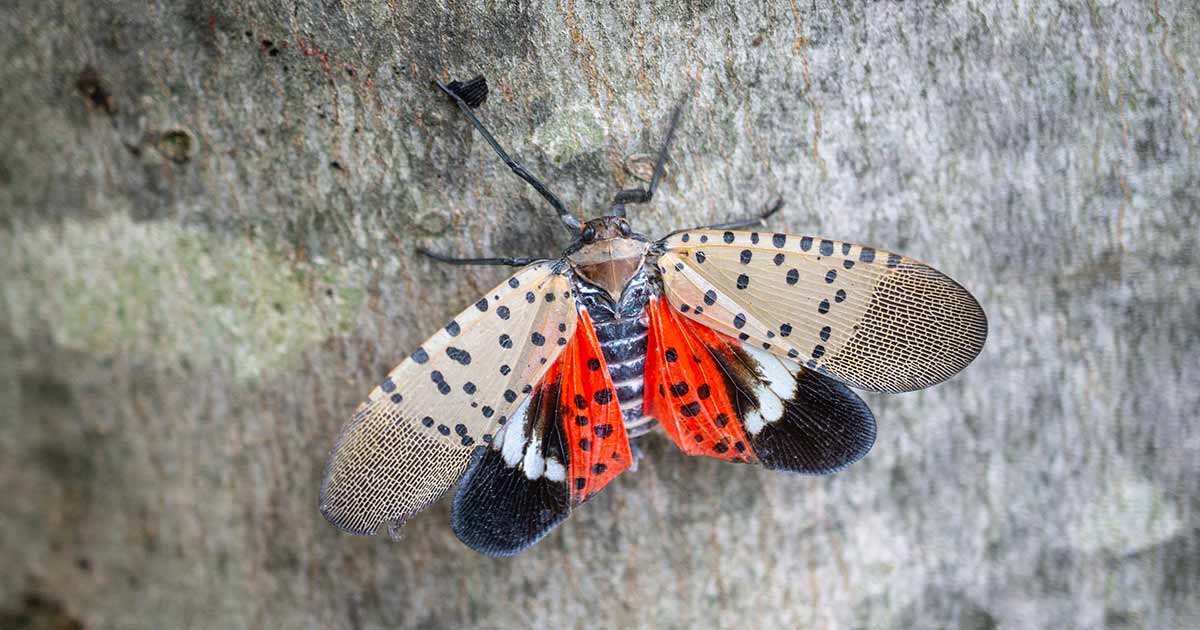

While a poor flyer, the Spotted Lanternfly is a strong jumper.

The abdomen is bright to pale yellow with bands of black on the top and bottom surfaces. The red portion of the wing is also adorned with black spots. When startled or flying the Spotted Lanternfly will display hind wings that are red at the base and black at the tip with a white stripe dividing them. The tips of the wings are a combination of black rectangular blocks with grey outlines. Adults at rest have a black head and grayish wings with black spots. In Korea, the Spotted Lanternfly is known to gradually prefer Tree-of-Heaven/Paradise Tree ( Ailanthus altissima) as it nears the adult stage.įirst Instar Spotted Lanternfly (Lycorma delicatula) Nymphįourth Instar Spotted Lanternfly (Lycorma delicatula) NymphĪdults can be seen as early as the middle of July and take on a much different appearance.

Nymphs spread from the initial site by crawling or jumping up any woody or non-woody plant it comes across to feed. As it grows, the Spotted Lanternfly develops red patches in addition to the white spots. The first instar nymph is black with white spots and wingless. The first of four immature stages, or instars, began emerging from the egg masses in mid-May, with a few individuals that had molted to second instar nymphs by the end of May. In Pennsylvania, the Spotted Lanternfly overwinters in egg masses laid on smooth bark, stone, and other vertical surfaces. Photograph by Holly Raguza, Pennsylvania Department of AgricultureĮarly detection is vital to the effective control of this pest and the protection of PA agriculture and natural resources-related businesses. Lycorma adult with wings spread showing colorful hind wing Townships and Burroughs in eastern Pennsylvania, including Philadelphia, are under a limited movement quarantine as the Department and its federal, state, local and non-governmental cooperators develop a strategy to eliminate this pest from the Commonwealth. Upon determination that the potential impact to Pennsylvania’s agricultural economy and natural resources was great, the Pennsylvania Department of Agriculture issued a quarantine with the intent to restrict the movement of the Spotted Lanternfly on November 1, 2014. On September 22, 2014, the Pennsylvania Department of Agriculture, in cooperation with the Pennsylvania Game Commission, confirmed the presence the Spotted Lanternfly (Lycorma delicatula, (WHITE)) in Berks County, Pennsylvania, the first detection of this non-native species in the United States. This pest poses a significant threat to the state’s more than $20.5 million grape, nearly $134 million apple, and more than $24 million stone fruit industries, as well as the hardwood industry in Pennsylvania which accounts for $12 billion in sales. In the U.S., the Spotted Lanternfly has the potential to greatly impact the viticulture (grape), tree fruit, plant nursery and timber industries. In Korea, where it was first detected in 2004, the Spotted Lanternfly is known utilize more than 70 species, 25 of which also occur in Pennsylvania, including cultivated grapes, fruit trees, and hardwood species.

The Spotted Lanternfly is a plant hopper native to China, India and Vietnam, and has been introduced in South Korea and Japan. Photograph by Lawrence Barringer, Pennsylvania Department of Agriculture What is the Spotted Lanternfly? Lateral view of an adult Spotted Lanternfly (Lycorma delicatula)


 0 kommentar(er)
0 kommentar(er)
